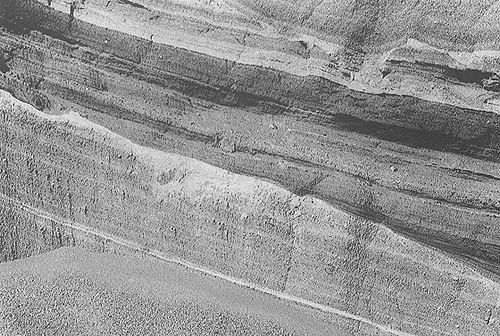
Erosional surfaces
Plate 70

Erosional surfaces
Plate 70
Erosional surfaces, more than other structures, pose two problems: 1) how to identify them; 2) how to interpret them.
Identification: in this outcrop of pyroclastic deposits, three discontinuities can be recognized in the vertical succession of beds. Two of them can be seen quite easily because they truncate underlying beds and show minor irregularities. The lower one is covered by discordant (onlapping) beds, the upper by conformable beds. The third surface is more elusive, being almost parallel to bedding surfaces. It marks the top of the darker bedset. Local evidence of truncation can be detected along it by careful observation.
Summarizing, erosional surfaces can be recognized by looking for anomalous contacts, such as angular unconformities, below and above them, or for minor morphological features along them. A basic rule is the following: bedding planes never cross a discontinuity surface; they terminate against it either from above or from below or are parallel to it.
Interpretation: bed truncation is an obvious indication of erosion. A fundamental point is understanding, if possible, whether the erosion has been synchronous or diachronous. Synchronous means almost instantaneous, or anyway related to a single event, usually a catastrophic one. Diachronous means that erosion occurred in discrete, successive steps over a geologically significant time span. Erosion surfaces due to the cumulative effects of channel migration, as we have seen (plate 15, are diachronous. A diachronous surface must have been exposed to air or water before being covered by sediment. It is also likely that deposition occurred stepwise on it, and was diachronous too.
Although there is some geometrical evidence helping us to decide whether erosion was synchronous or diachronous, the key argument consists in dating it by stratigraphic methods. What can be dated is not the surface itself but the beds lying immediately below and above it. If the time difference is negligible, then the erosion was rapid (short-lived). If not, the surface is diachronous, and erosion lasted for part of the measured time gap (another part is represented by the canceled stratigraphic record). Unfortunately, the normal resolution of geologic clocks, especially in clastic sediments, is too poor for this test to be significant.
Pleistocene pyroclastics, Salina, Archipelago, Tyrrhenian Sea
Erosion produces a varied relief with all scales of roughness. Specific features, or elements, of these surfaces are what can be called erosional structures (channels, scours, etc.: see plates 73-77). It is not easy, however, to define and pigeonhole morphological characters that often grade into one another.
At the largest scale, erosional surfaces are complex and constitute traces of fossil landscapes. In stratigraphic sections, they have the character of discontinuities, or breaks in sedimentation if the succession is entirely sedimentary. Remember, in this respect, that all bedding surfaces are discontinuities, and we do not know in advance the entity of the temporal gap across them. This implies that every surface of discontinuity must be regarded with suspicion: it could conceal an important hiatus, even if it does not truncate older beds at a high angle or is not accompanied by traces of weathering, paleosols, etc.